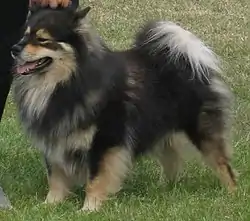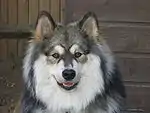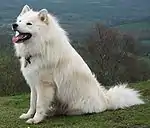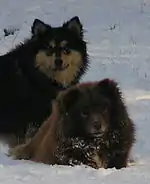Finnish Lapphund
The Finnish Lapphund (or Finnish Lapponian Dog) is a hardy, easy going, medium-size breed of Spitz type. Traditionally it has been used for herding reindeer. Although it is one of the most popular dog breeds in its native country, Finland, it is not very numerous outside of the Nordic countries.
| Finnish Lapphund | |||||||||||||
|---|---|---|---|---|---|---|---|---|---|---|---|---|---|
 | |||||||||||||
| Other names | Finnish Lapponian Dog (FCI name) Lapinkoira Suomenlapinkoira | ||||||||||||
| |||||||||||||
| Dog (domestic dog) | |||||||||||||
Lineage
The breed falls under the mitochondrial DNA sub-clade referred to as d1 that is only found in northern Scandinavia. It is the result of a female wolf-male dog hybridization that occurred post-domestication.[1][2] Subclade d1 originated 480–3,000 years ago and is found in all Sami-related breeds: Finnish Lapphund, Swedish Lapphund, Lapponian Herder, Jamthund, Norwegian Elkhound and Hällefors Elkhound. The maternal wolf sequence that contributed to these breeds has not been matched across Eurasia[3] and its branch on the phylogenetic tree is rooted in the same sequence as the 33,000 year-old Altai dog (not a direct ancestor).[4]
Appearance

The Finnish Lapphund is a medium-sized, strongly-built dog. It has a profuse coat with pricked, highly mobile ears, distinctive markings and an elegant nose. Colours of black:cream, tan, white and gray, brown and white also brown and cream. There is also a pear black, white and gray. The breed standard is 46 to 52 centimetres (18 to 20 in) at the withers for a male, and a slightly smaller 41 to 47 centimetres (16 to 19 in) for a female. However, some variation is allowed, since the breed standard states that the type is more important than the size. A typical male of 49 cm height normally weighs 17 to 19 kilograms (37 to 42 lb), but the breed has a weight range of 15 to 24 kilograms (33 to 53 lb), depending on the size of the dog.
The Lapphund has a profuse double coat, with a short, fluffy undercoat and a longer topcoat. The coat makes the dog waterproof as well as resistant to extreme cold. In Finland, only two dog breeds are legally allowed to be kenneled outdoors in winter: the Finnish Lapphund and the Lapponian Herder.[5] The profuse hair around the head and neck gives the distinct impression of a mane in most males. Although the coat is profuse, it requires only a modest amount of maintenance. Weekly brushing is recommended throughout the year, except during shedding seasons, where a daily brush may be required.
A wide variety of colors and markings are found in Finnish Lapphunds. Any colour is allowed in the breed standard, although a single colour should predominate. One of the most common colour combination's is black and tan: a predominantly black dog with tan legs and face. Common colourations may include crème, black, red, brown, sable and wolf-sable. In descending order of dominance, the following genes in certain series correspond to specific colourations:[5]
A series (Agouti):
- Ay: dominant yellow or sable (which produces various types of red and sable)
- aw: wolf sable or grizzle
- as:saddle
- at: black and tan
- a: recessive black
B series (brown)
C series (colour):
- C: CC pairing displays deep rich tan
- Ce: not fully defined (potential lightening effect)
- cch: Chincilla (lightens yellow to cream or faw)
E series (extension)
- Em: black mask
- E: no black mask
- Ebr: brindle
- e: conversion/fading of black to yellow

Many Finnish Lapphunds have very distinctive facial markings. One of the unusual facial markings is "spectacles", where a ring of lighter coloured hair around the eyes gives the impression that the dog is wearing spectacles. The spectacles of the Finnish Lapphund, while reminiscent of their cousins, the Keeshond, are larger and more pronounced. Like other spitz types, the tail is carried curving over the back. The Finnish Lapphund has a tail covered with thick, long hair. The tail may hang whilst the dog stands.

The Finnish Lapphund is a recognized breed in Finland, Europe, Great Britain, Australia and the United States. The breed standards are mostly identical, with a few minor exceptions: in the English standard, the acceptance of tipped ears is omitted.
Temperament
The Finnish Lapphund is a very intelligent and active breed. Finnish Lapphunds take well to training due to their intelligence. Some owners and fanciers claim that "Lappies" even have the ability to think through actions first. Although small in number worldwide, a noticeable number of Finnish Lapphunds have excelled in activities such as obedience trials, agility, herding trials, and pet therapy.
The breed is friendly and alert, and makes a good watch dog, due to its tendency to bark at unfamiliar things. The breed was originally used to herd reindeer by droving, and barking helped it to be distinguished from wolves. Even when not herding, the Finnish Lapphund tends to bark with a purpose, and more rare cases of problem barking can normally be controlled by training.
The breed makes the ideal outdoor companion. It is active, coldproof, and waterproof, and will gladly accompany people on walking or running trips. A slight independent streak is common, though with training Finnish Lapphunds can have excellent recall and obedience skills.
Lappies are ideal choice for a family with small children. The breed adapts well to family life, including being responsive to children. Finnish Lapphunds have a gentle nature with children, people with disabilities, and the elderly. This is a very friendly breed and it normally avoids and flees from threatening situations. The breed is very curious, so some supervision is recommended.

In Finland, many Finnish Lapphunds have won national championships for obedience and lappies are also suitable for agility.
Activities
The Finnish Lapphund can compete in dog agility trials, carting, mushing, obedience, Rally obedience, showmanship, flyball, tracking, and herding events. Herding instincts and trainability can be measured at noncompetitive herding tests. Lapphunds exhibiting basic herding instincts can be trained to compete in herding trials.[6]
Health
The Finnish Lapphund is a naturally healthy breed, and typically lives 12–14 years, although dogs of 16–17 years are not uncommon in Finland.[5]
Known medical issues include Generalised progressive retinal atrophy (GPRA) and hereditary cataracts.
- GPRA is a progressive eye disease that can cause permanent blindness in dogs. In the Finnish Lapphund, this tends to be late onset, but can typically appear between the ages of 1 and 8 years. GPRA is a genetic illness, and is transmitted via an autosomal recessive gene. A reliable genetic test for the prcd-form of GRPA has been developed by OptiGen,[7] and breeders are increasingly testing breeding animals before deciding on suitable mating pairs. The Finnish Lapphund club of Great Britain adopted an ethical policy in 2006 that matings will only be allowed if the progeny can not be affected by GPRA. In 2001, 2.5% dogs of Finnish dogs were affected by PRA.[5]
- Some Lapphunds are affected by cataracts, with 3.4% of Finnish dogs affected. Cataracts can be caused by a number of factors, and the mode of inheritance is not yet well understood. Since the incidence in Finland is relatively high, the disease is considered to be hereditary. In the UK and USA the number of affected dogs is very small.[5]
- The ethical standard in most countries require the stud dogs to be hip-scored, but the incidence of hip dysplasia is low.
History
The breed has its origins as a reindeer herder of the Sami people. The Sami are an indigenous people residing in areas now divided between Finland, Sweden, Norway, and Russia.[8] Traditionally, reindeer herding has been very important for the Sami people, and they are still involved in herding today. The Sami have used herding dogs for centuries, and these dogs were typically long in body, somewhat rectangular in shape, with long hair and a straight tail that would curl up over the back when the dog was moving.[5] Finnish Lapphunds are the most similar to the long haired dogs developed by the Sami people in order to assist them with herding, often favored as winter herders for the reindeer.[9]
Norwegians and Swedes were among the first to consider standardizing the dogs of Lapland prior to World War II. In the post war years, the dogs of Lapland were at serious risk due to distemper outbreak.[10] Swedish Lapphund breeders today believe that their breed, and other Lapphund breeds, were in serious danger of extinction.[11] A standard for the related Swedish Lapphund was adopted in 1944 in FCI (Federation Cynologique Internationale), and the Finnish Lapphund standard soon followed.
In Finland, the first breed standards were set in 1945 by the Finnish Kennel Club, who called the breed the Lappish Herder, also known as Kukonharjunlainen. It is believed that these dogs were the result of a cross between the Karelian Bear Dog and the reindeer dogs, and had short hair. In the 1950s the Finnish Kennel Association (the second major kennel association in Finland) created the first breed standard for the Lapponian herder. Acceptable colours for this breed were black, bear-brown and white.[5]

In the 1960s, the various Finnish kennel associations were unified, and in 1966 the breeds were reassessed. This resulted in the formal definition of two breeds: the Lapponian herder with a shorter coat was defined in 1966, and the longer coated Finnish Lapphund was defined in 1967.[5]
At about the same time, technology enabled changes in the lifestyle of the Sami herders. Previously, the longer-haired dogs were generally preferred for herding, but with the advent of snowmobiles, the preference started to change in favour of the shorter haired Lapponian herder.[5] However, popularity did not die for the longer-haired breed, which as of 2014 was ranked the sixth most popular companion animal in Finland.[12]
The first American litter was born in 1988. In 1994, the breed was recognised by the United Kennel Club (UKC), the second largest kennel club in America, in the Northern Group.[13] The breed was accepted into the AKC Miscellaneous Group on July 1, 2009 and became a fully recognized breed in the Herding Group on June 30, 2011.[14][15] The Finnish Lapphund Club of America (FLCA) is the parent organization in the United States and was awarded parent club status on November 25, 2015, thus allowing it to hold licensed championship point events.[15]
The breed was first introduced to the United Kingdom in 1989 and is represented by the Finnish Lapphund Club of Great Britain.[16] It was introduced to Australia and Canada in 1995 and is accepted by the New Zealand Kennel Club and Canadian Kennel Club. In Canada, its parent club is the Finnish Lapphund Club of Canada.[17]
References
- Pang, J.-F.; Kluetsch, C.; Zou, X.-J.; Zhang, A.-b.; Luo, L.-Y.; Angleby, H.; Ardalan, A.; Ekstrom, C.; Skollermo, A.; Lundeberg, J.; Matsumura, S.; Leitner, T.; Zhang, Y.-P.; Savolainen, P. (2009). "MtDNA Data Indicate a Single Origin for Dogs South of Yangtze River, Less Than 16,300 Years Ago, from Numerous Wolves". Molecular Biology and Evolution. 26 (12): 2849–64. doi:10.1093/molbev/msp195. PMC 2775109. PMID 19723671.
- Duleba, Anna; Skonieczna, Katarzyna; Bogdanowicz, Wiesław; Malyarchuk, Boris; Grzybowski, Tomasz (2015). "Complete mitochondrial genome database and standardized classification system for Canis lupus familiaris". Forensic Science International: Genetics. 19: 123–129. doi:10.1016/j.fsigen.2015.06.014. PMID 26218982.
- Klütsch, C.F.C.; Savolainen, Peter (2011). "Regional occurrence, high frequency, but low diversity of mitochondrial dna haplogroup d1 suggests a recent dog-wolf hybridization in scandinavia". Journal of Veterinary Behavior: Clinical Applications and Research. 6: 85. doi:10.1016/j.jveb.2010.08.035.
- Thalmann, O.; Shapiro, B.; Cui, P.; Schuenemann, V. J.; Sawyer, S. K.; Greenfield, D. L.; Germonpre, M. B.; Sablin, M. V.; Lopez-Giraldez, F.; Domingo-Roura, X.; Napierala, H.; Uerpmann, H.-P.; Loponte, D. M.; Acosta, A. A.; Giemsch, L.; Schmitz, R. W.; Worthington, B.; Buikstra, J. E.; Druzhkova, A.; Graphodatsky, A. S.; Ovodov, N. D.; Wahlberg, N.; Freedman, A. H.; Schweizer, R. M.; Koepfli, K.- P.; Leonard, J. A.; Meyer, M.; Krause, J.; Paabo, S.; et al. (2013). "Complete Mitochondrial Genomes of Ancient Canids Suggest a European Origin of Domestic Dogs". Science. 342 (6160): 871–4. doi:10.1126/science.1243650. PMID 24233726.
- Jackson, Toni (2003). Finnish Lapphund: Special rare breed edition. USA: Kennel Club Books. ISBN 1-59378-374-4.
- Hartnagle-Taylor, Jeanne Joy; Taylor, Ty (2010). Stockdog Savvy. Alpine Publications. ISBN 978-1-57779-106-5.
- "OptiGen - PRA - Finnish Lapphund". www.optigen.com.
- "An introduction to the Sami people". boreale.konto.itv.se. Retrieved 2017-02-28.
- "Constitution and By-Laws (effective 2008) | Finnish Lapphund Club of Canada". www.finnishlapphund.ca. Retrieved 2017-02-28.
- "Finnish Lapphund". www.purina.com.au. Retrieved 2017-02-28.
- "Swedish Lapphund multi champion and multi winner Kristallens Lihkku's home page in English (Swedish Lapponian reindeer herding dog) www.lapphund.nu". www.lapphund.se. Retrieved 2017-02-28.
- "The Labrador Retriever was last year's most popular dog breed in Finland". www.kennelliitto.fi. Retrieved 2017-02-28.
- "United Kennel Club: Finnish Lapphund". www.ukcdogs.com. Archived from the original on 2016-08-26. Retrieved 2017-02-28.
- American Kennel Club. "Finnish Lapphund Dog Breed Information - American Kennel Club".
- "Finnish Lapphund Club of America | FLCA History". www.finnishlapphund.org. Retrieved 2017-01-12.
- "FLCGB Breed History". www.finnishlapphund-club.co.uk. Retrieved 2017-01-12.
- "History of the Finnish Lapphund Breed | Finnish Lapphund Club of Canada". www.finnishlapphund.ca. Retrieved 2017-01-12.
Books
- Jackson, Toni (2003). Finnish Lapphund: Special rare breed edition. USA: Kennel Club Books. ISBN 1-59378-374-4.
- Karppinen, S. Dogs of Lapland. 2013. ISBN 978-952-5969-24-5
Further reading
- Klütsch CFC, Seppälä EH, Lohi H, Fall T, Hedhammar Å, Uhlén M, Savolainen P (2010) Regional occurrence, high frequency but low diversity of mitochondrial DNA haplogroup d1 suggests a recent dog-wolf hybridization in Scandinavia. Animal Genetics, online early.